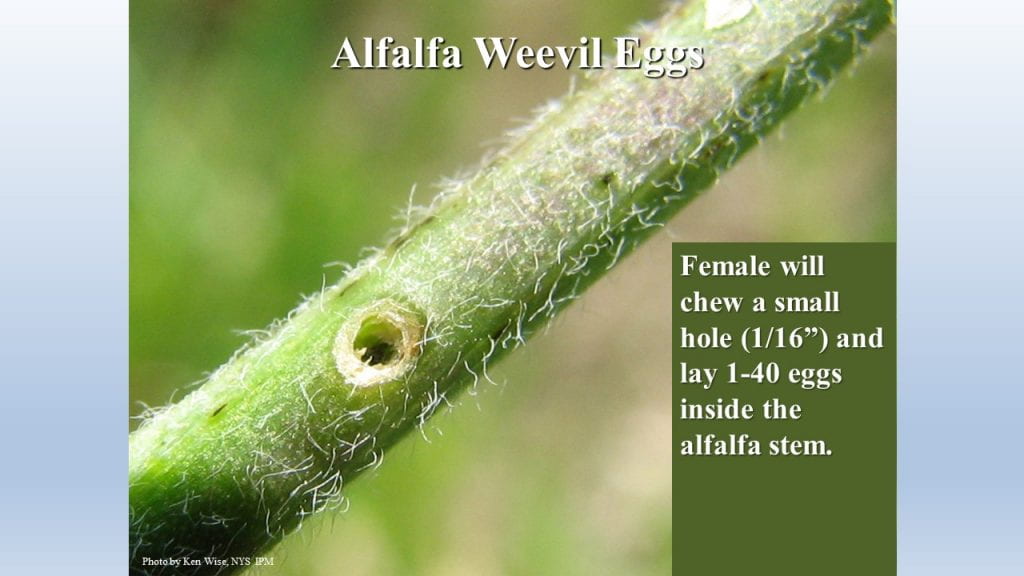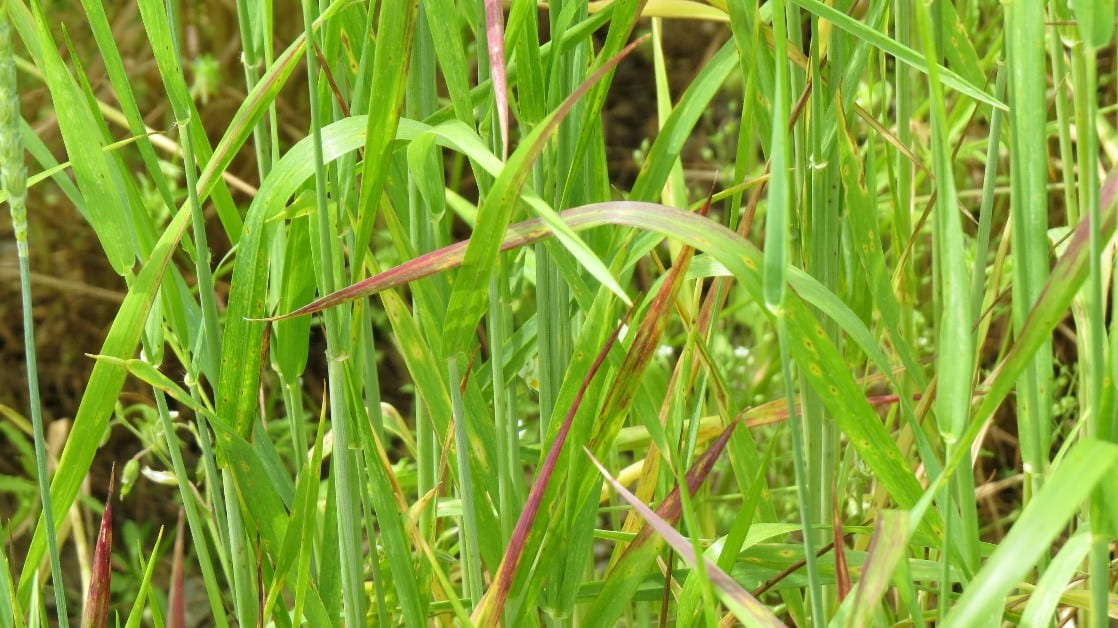Contents
View from the Field
This week there were two hot spots for black cutworm moths caught in pheromone traps. Amenia (Dutchess County) had 60 and Seneca Falls (Seneca County) had 17 moths caught. The hot spots for true armyworm were Sauquoit (Oneida County) 28 moths, Walton (Delaware County) 21 moths, Canajoharie (Montgomery County) 23 moths, and Seneca Falls (Seneca County) 30 moths caught. The definition of an intense catch was changed to 15 moths per week. We will set the biofix date for different locations when a trap reaches 15 moths in a week. For each location, 90-degree days for black cutworm and 113-degree days for true armyworm is when larvae will start hatching, and that’s a good time to start scouting for these two insect pests in corn.
Jodi Putman (CCE NY Northwest Dairy and Field Crops Team) reports finding alfalfa weevil adults in alfalfa fields. The adults will chew a hole inside the new stem growth and lay eggs. These eggs hatch at about 280 degree-days at a base temperature of 48 degrees.
Figure 1: Alfalfa weevil adult
Figure 2: Alfalfa weevil chew holes in a stem to lay eggs.
Figure 3: Alfalfa weevil eggs
Jaime Cumming (NYS IPM) and Christian Malsatzki (CCE Ulster County) report finding low levels of powdery mildew on small grains. Jaime reports that Powdery Mildew can be commonly found lower in the canopy of all small grain crops, and is easily identifiable by its white, fuzzy fungal growth on both the upper and lower leaf surfaces (Fig. 4). This pathogen overwinters on straw residues, which provide inoculum in the spring to blow into growing wheat stands. Cultivars vary in their levels of resistance to powdery mildew, and resistance is the most cost-effective method of defense.
Figure 4. Powdery mildew of wheat (photo by Ken Wise, NYS IPM).
Jaime Cummings (NYS IPM) and Dr. Gary Bergstrom (Cornell University) report finding low levels of Stagonospora Leaf Blotch in wheat. This disease is found in most small grains field each year and normally occurs at low levels. On occasion, it can increase and possibly cause some yield losses.
Figure 5. Stagonospora leaf blotch of wheat (photo by Ken Wise, NYS IPM).
Aaron Gabriel (CCE Capital District) reports finding low levels of barley yellow dwarf virus disease. Aphids transmit this disease in the fall. Four of the more common aphids that transmit the disease in the Northeast are oat birdcherry aphid (Rhoplasiphum padi), the corn leaf aphid (R. maidis), the English grain aphid (Sitobion avenae) and greenbug (Schizaphis graminum).
Figure 6: Barley Yellow Dwarf (photo by Ken Wise, NYS IPM)
Fusarium head blight commentary, May 22, 2020:
Gary Bergstrom, Extension Plant Pathologist, Cornell University
Winter malting barley in much of New York is emerging from the boot and this is a critical time to consider a fungicide application. The Fusarium Risk Assessment Map (http://www.wheatscab.psu.edu/ ) today indicates a moderate to high risk of Fusarium head blight (FHB) for some areas of New York. Rain showers and thunderstorms are in local forecasts over the next week; duration of leaf/head wetness is more important for FHB development than is the amount of precipitation. Maximal suppression of FHB and grain contamination by deoxynivalenol (DON) mycotoxin results when fully emerged heads of winter malting barley are sprayed with DMI (FRAC Group 3) containing fungicides Caramba, Prosaro, or Miravis Ace (latter includes FRAC Group 7 fungicide). A heads-emerged spray with these fungicides also protects upper leaves against fungal leaf blotches, powdery mildew, and rust. Scald has already been observed on susceptible varieties. Foliar sprays of any of these three products up to seven days after head emergence may still result in significant FHB and DON suppression. Fungicide products containing QoI (FRAC Group 11) fungicides should not be applied to headed wheat or barley as they may result in increased levels of DON in grain.
Winter wheat is generally a week or more behind in development from winter barley planted on the same fall date. Winter wheat in New York varies from stem elongation to flag leaf visible stages. We should reach the critical fungicide application window for winter wheat over the next two weeks. The DMI (FRAC Group 3) containing fungicides Caramba, Prosaro, or Miravis Ace (latter includes a FRAC Group 7 fungicide) are the most effective fungicides for suppression of FHB and DON contamination when applied at flowering (emergence of yellow anthers on heads). A flowering application of these fungicide products should be based on Fusarium head blight (FHB) risk as well as the risks of powdery mildew, rusts, and fungal leaf blotches in the upper canopy based on scouting of individual fields. Stagonospora nodorum blotch and powdery mildew have already been observed. There is an application window of approximately 7 days from the beginning of flowering in which reasonable FHB and DON suppression can be expected. Check the Fusarium Risk Assessment Tool (http://www.wheatscab.psu.edu/ ) and your local weather forecast frequently as your winter wheat crop approaches heading and flowering.
Black Cutworm Moths Caught
True Armyworm Moths Caught
Alfalfa Weevil, Seed Corn Maggot and Base 50 F Degree Days for May 26, 2020
Alfalfa Degree Days Life Stages
(Base Temperature 48F)
Egg Hatch 280
Instar 1 351
Instar 2 395
Instar3 470
Instar 4 550
Cocooning 600
Pupa 725
Adult Emergence 815
Source: Growing Alfalfa the IPM Way
Seed Corn Maggot Flight Degree-Day Model for Egg Laying
| Base Temp = 390 F | Peak 1st Generation | Seed corn maggot fly free degree days | Peak 2nd Generation | Seed Corn maggot fly free degree days | Peak 3rd Generation | Seed Corn Maggot fly Free degree days |
| degree days | 360 | 810 | 1,080 | 1530 | 1800 | 2250 |
Source: Insect IPM for Organic Field Crops: Seed Corn Maggot by Katelin Holm and Eileen Cullen
Black Cutworm and True Armyworm Degree Days
Black Cutworm Degree Days (Base 500 F) Lifecycle Growth Stages
Degree Days Stage Feeding Activity
0 Moth Capture Egg Laying
90 Eggs Hatch
91-311 1st to 3rd Instar Leaf Feeding
312-364 4th Instar Cutting Begins
365-430 5th Instar Cutting Begins
431-640 6th Instar Cutting Slows
641-989 Pupa No feeding
Source: University of Minnesota Insect Pest of Corn-Stand Reducers Black Cutworm
True Armyworm Degree Days (Base 500 F) Lifecycle Growth Stages
Degree Days Stage Feeding Activity
0 Moth Capture Egg Laying
113 Eggs Hatch
612 Larval stages Leaf Feeding
909 Pupa No feeding
Clipboard Checklist
Keith Waldron, NYS IPM
General
*Walk fields to check tile flow, check and clear drainage outlets. Look for line breaks
*Note and record location of wet areas on field maps or aerial photo for future tiling considerations and crop decisions, check for areas of soil erosion
*Pre-plant weed evaluation, timing cultivation and/or pre-plant weed management
*Watch for early season weeds: winter annuals, chickweed, henbit, field penny cress, shepherd’s purse, giant and common ragweed, purple deadnettle, lambsquarters, redroot pigweed, velvet leaf, Pennsylvania smartweed, common sunflower, quackgrass, foxtail
Alfalfa:
*Evaluate established legume stands for winter damage (thinning stand, frost heave, Brown root rot), determine average alfalfa stand count adjust crop plans if necessary
*Monitor for alfalfa weevil, crown or foliar diseases
*Monitor new seedings for Pythium blight and Phytopthora Root Rot.
*Monitor for Alfalfa Snout Beetle (In Oswego, Jefferson, Cayuga, Wayne, Lewis, St. Lawrence, Clinton, Essex, and Franklin counties)
Small Grains:
*Monitor winter grain fields for over wintering survival (snow mold and other cold injury issues), weed issues (such, as winter annuals, corn chamomile and chickweed), growth stage, number of tillers, foliar diseases (powdery mildew, rusts)
*Check stands for soilborne virus diseases, Wheat spindle streak mosaic and Soilborne wheat mosaic, check for signs of powdery mildew or other maladies, cereal leaf beetle, weed escapes, goose damage
Corn:
*Prepare land and plant corn as conditions allow
*Pre-plant weed evaluation, timing cultivation and/or pre-plant weed management
*Emergence: assess stand, population count
Soybeans:
*Prepare land and plant soybeans as conditions allow
*Pre-plant weed evaluation, timing cultivation and/or pre-plant weed management
Pastures:
*Check and mend fences as needed.
*Check crop growth
*Monitor fields for invasive species, plants harmful to livestock
*Review/Plan rotation system
Equipment:
*Remove / clean soil and crop debris from equipment
*Arrange for custom weed control or check your own application or cultivator equipment for repairs.
*Carry appropriate / necessary NYS DEC and EPA required documents: (pesticide applicators license, pesticide labels, MSDS sheets, etc.) with application equipment
*Calibrate:
-planting equipment – maintain records on planting rate per field
-manure spreaders – maintain records on amount spread per field
-pesticide application equipment – Check nozzles, pumps, etc., recalibrate pesticide application equipment before use.
Storage:
* Check stored grain bins for temperature, moisture and signs of mold and insects. Aerate, core, transfer grain or treat as necessary
*Check forage allocation and anticipate feed program adjustments as forages from previous year are used up
*Plan where forages should be stored for optimum allocation next feeding season











